Research highlights 2013
Patterned growth of crystalline organic heterostructures
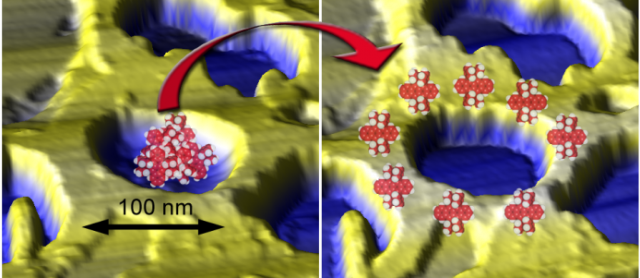
The successful growth of organic heterostructures, fully controlled in terms of purity and crystallinity (and, therefore, of all the physical properties), is still a challenge in view of the possible device applications of organic semiconductors. In this Communication crystalline organic heterostructures with sharp and epitaxial interfaces between the constituend materials, here rubrene and quaterthiophene, and with a characteristic nanopatterned surface are grown by organic molecular beam epitaxy. Starting from a first layer of amorphous rubrene droplets, upon deposition of a second layer of quaterthiophene the droplets undergo crystallization, giving rise to a fully crystalline heterostructure, patterned over a scale of few hundreds nm. This result can be achieved only after a proper choice of the substrate material, driven by the characteristics of the molecules under study, which has to favor epitaxy, the ultimate driving force for the whole process. The new two-step growth method is defined here organic droplet epitaxy.
A. Sassella, L. Raimondo, M. Campione, A. Borghesi, Patterned growth of crystalline organic heterostructures, Advanced Materials 25, 2804 (2013)
Highly ordered alignment of a vinyl polymer by host–guest crosspolymerization
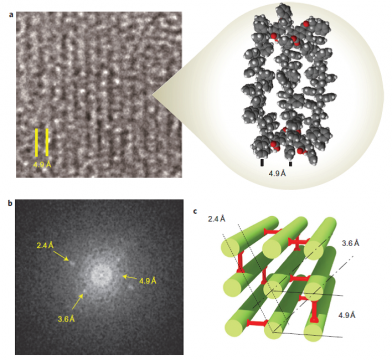
Host–guest cross-polymerization has been investigated as a tool for the synthesis of crosslinked polymers endowed with pseudocrystallinity. Our method is based on a porous metal-organic framework that provides engineered nanovessels that expose the reactive moieties on the inner surface of the micropores and generate crosslinking among uniaxially aligned polymer chains at specific locations. The newly synthetized polymeric material exhibits unconventional characteristics because the pseudocrystallinity is realized in the presence of atactic polymer chains, which are not amenable to crystallization. The precise order of the host matrix is transferred into a polymeric material at both the molecular and morphological hierarchical levels.
G. Distefano, H. Suzuki, M. Tsujimoto, S. Isoda, S. Bracco, A. Comotti, P. Sozzani, T. Uemura and S. Kitagawa, Highly ordered alignment of a vinyl polymer by host–guest crosspolymerization, Nature Chem. 5, 335-341 (2013)
Unexpected dominance of vertical dislocations in high-misfit Ge/Si(001) films and their elimination by deep substrate patterning
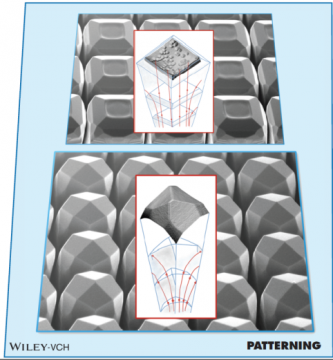
From the cover of the Communication Section, Adv. Materials vol. 25 (2013): “An innovative strategy in dislocation analysis is described byAnna Marzegalli et al. on page 4408, demonstrating that vertical dislocation”.
Marzegalli, A; Isa, F; Groiss, H; Muller, E; Falub, C; Taboada, A; Niedermann, P; Isella, G; Schaffler, F; Montalenti, F; von Kanel, H; Miglio, L. Unexpected dominance of vertical dislocations in high-misfit Ge/Si(001) films and their elimination by deep substrate patterning, Advanced materials, 25(32), 4408-4412 (2013)
Coverage-Induced Hydrogen Transfer on ZnO Surfaces: From Ideal to Real Systems
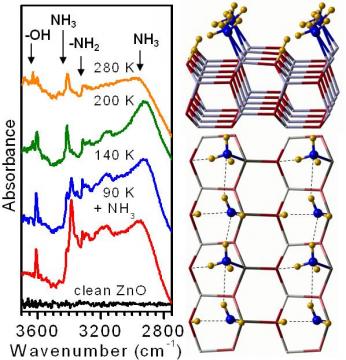
Deprotonating a base: High surface coverage is found to be capable of inducing hydrogen transfer from adsorbed ammonia to surface oxygen atoms on ZnO of both single crystals and nanoparticles by means of HREELS and UHVFTIRS vibrational spectroscopies and confirmed by density functional theory calculations.
H. Noei, F. Gallino, L. Jin, J. Zhao, C. Di Valentin, and Y. Wang, Coverage-Induced Hydrogen Transfer on ZnO Surfaces: From Ideal to Real Systems, Angewandte Chemie Int. Ed. 52, 1977-1881 (2013)
Electron transfer at oxide surfaces. The MgO paradigm: from defects to ultrathin films
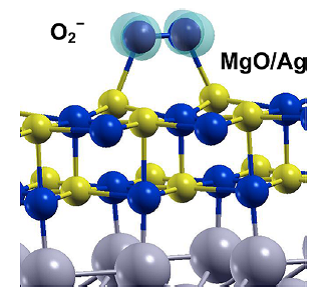
This is comprehensive review on electron transfer at oxide surfaces. Using magnesium oxide as an example, it is discussed as charge transfer from the oxide support to adsorbed species determines the chemistry of these systems. The role of defects and nanostructure in charge transfer is discussed with particular attention to the recently discovered class of ultrathin oxide films.
G. Pacchioni, H. J. Freund, Electron transfer at oxide surfaces. The MgO paradigm: from defects to ultrathin films, Chemical Reviews, 113, 4035-4072 (2013)
Measure of surface potential at the aqueous-oxide nanoparticle interface by XPS from a liquid microjet

The surface potential at a water−oxide nanoparticle interface, long considered an immeasurable direct quantity, has been measured by X-ray photoelectron spectroscopy (XPS) from a liquid microjet for aqueous suspensions of 9 nm colloidal silica (SiO2) at pH 0.3 and 10.0, where the surface potential changes from positive to negative. The experimental results are consistent with calculated surface potentials based on Guoy−Chapman theory.
M. A. Brown, A. Beloqui Redondo, M. Sterrer, B. Winter, G. Pacchioni, Z. Abbas, J. A. van Bokhoven. Measure of surface potential at the aqueous-oxide nanoparticle interface by XPS from a liquid microjet, Nano Letters, 13, 5403-5407 (2013)